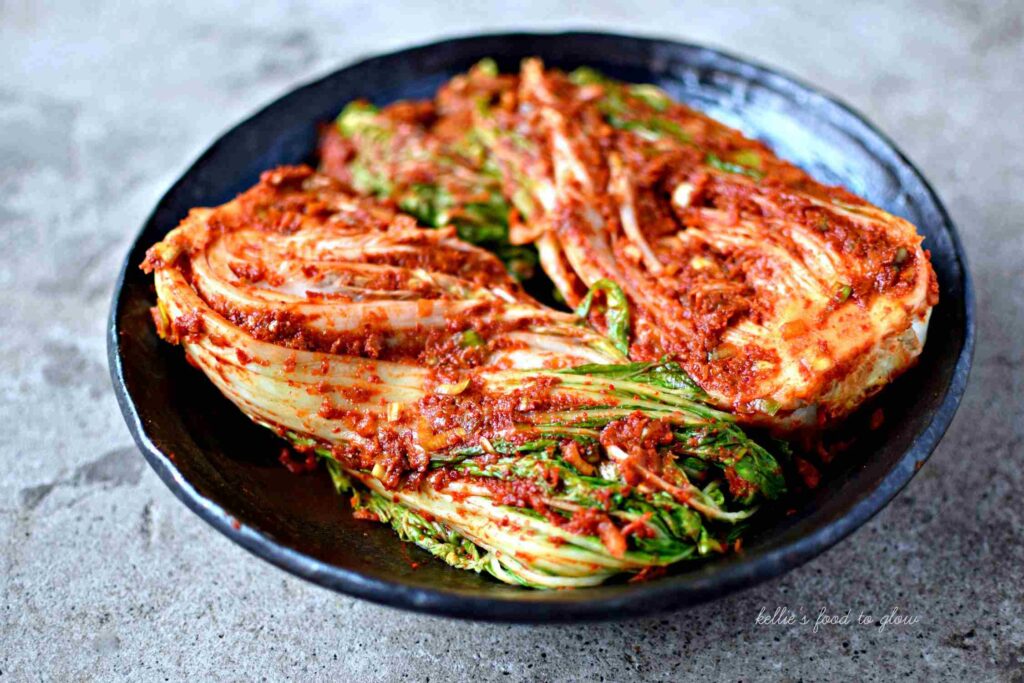
Kimchi, a staple in Korean cuisine, holds a special place in the hearts and palates of people around the world. Beyond being a beloved side dish, kimchi represents the cultural and historical significance of Korea. In this article, we will delve into the distinct characteristics of fresh kimchi vs fermented kimchi. These two variants offer unique taste experiences and health benefits.
Fresh Kimchi

Fresh kimchi (geotjeori), as the name suggests, is made from fresh ingredients and offers a delightful burst of flavors. Let’s explore its defining characteristics.
Definition and Characteristics
- Fresh Ingredients and Texture: Fresh kimchi is crafted using raw vegetables, such as napa cabbage, radishes, and green onions, which retain their crisp texture. The vibrant colors of the ingredients add to its visual appeal.
- Initial Spiciness and Crunchiness: Fresh kimchi tends to be spicier and have a robust crunch due to the unfermented state of the ingredients.
- Raw Vegetable Profile: Fresh kimchi showcases the raw flavors and natural sweetness of the vegetables, providing a refreshing and invigorating taste experience.
Health Benefits
Fresh kimchi not only tickles the taste buds but also offers a multitude of health benefits.
- Rich in Vitamins and Minerals: The fresh vegetables used in kimchi are packed with essential vitamins (such as vitamin C, vitamin K, and vitamin A) and minerals (including calcium, potassium, and iron), which support overall well-being.
- Enhancing Digestive Health: The raw and fibrous nature of fresh kimchi aids digestion and promotes a healthy digestive system.
- Boosting Immune System: The high vitamin content in fresh kimchi contributes to a strengthened immune system, helping to ward off common illnesses.
Fermented Kimchi

Fermented kimchi offers a distinctive tangy flavor profile and a multitude of complex aromas. Let’s explore the characteristics that set it apart.
Definition and Characteristics
- Transformation of Flavors and Texture: Fermentation brings about a transformation in the taste and texture of kimchi. The flavors develop and intensify over time as the natural process of fermentation progresses.
- Development of Umami Taste: Fermented kimchi offers a unique umami taste, characterized by its savory, slightly tangy notes. The fermentation process enhances the depth and complexity of flavors.
- Complexity of Aromas: Fermented kimchi boasts a rich and complex aroma profile. From the pungent aromas of garlic and ginger to the earthiness of fermented vegetables, this variant tantalizes the olfactory senses.
Health Benefits
Beyond its delectable flavors, fermented kimchi offers a range of health benefits that stem from the fermentation process.
- Probiotic Powerhouse: Fermented kimchi is a natural source of probiotics, which are beneficial bacteria that support gut health and aid in digestion.
- Promoting Gut Health: The probiotics in fermented kimchi help maintain a healthy balance of gut bacteria, improving overall digestive health and reducing the risk of gastrointestinal issues.
- Potential Anti-Cancer Properties: Fermented kimchi contains bioactive compounds that have been linked to potential cancer-fighting properties, although further research is needed to establish conclusive evidence.
Taste Comparison: Fresh Kimchi vs. Fermented Kimchi
Fresh kimchi and fermented kimchi offer distinctive flavor profiles and textures. Let’s dive into the differences in taste.
Flavor Profiles
- Fresh Kimchi: Bold and Fresh Notes
- Fresh kimchi delivers vibrant, bold flavors that are more pronounced due to the absence of fermentation. The natural sweetness of the vegetables shines through alongside the initial spiciness, creating a refreshing and invigorating taste experience.
- Fermented Kimchi: Tangy, Sour, and Umami Flavors
- Fermented kimchi carries tangy and sour undertones, thanks to the fermentation process. The umami flavors brought forth by the fermentation create a depth of taste that is both savory and slightly acidic, resulting in a complex and satisfying culinary experience.
Texture Differences
- Fresh Kimchi: Crunchy and Firm
- As fresh kimchi is made with raw vegetables, it retains a satisfying crunch and firm texture. Every bite bursts with a delightful crispness, creating a pleasing contrast against the flavors.
- Fermented Kimchi: Soft and Slightly Pungent
- Over time, the fermentation process softens the vegetables in fermented kimchi, giving it a softer texture. The pungent aroma and tangy flavors complement the softer bite, offering a unique texture for those who enjoy a more tender kimchi experience.
Culinary Uses and Pairings
Both fresh and fermented kimchi have their own culinary roles. Here are some suggestions for incorporating them into various dishes.
- Utilizing Fresh Kimchi in Salads, Wraps, and Stews:
- Fresh kimchi’s vibrant flavors and texture make it perfect for adding to salads, such as a refreshing kimchi coleslaw. It can also be wrapped in lettuce leaves for a light and flavorful snack or incorporated into stews to add a punch of flavor.
- Incorporating Fermented Kimchi in Fried Rice, Noodles, and Pancakes:
- Fermented kimchi’s tangy and umami flavors work wonders when combined with fried rice, noodles, or pancakes. The inclusion of fermented kimchi adds depth and complexity to these dishes, taking them to a whole new level of deliciousness.
Choosing Between Fresh Kimchi vs Fermented Kimchi
When deciding between fresh and fermented kimchi, several factors come into play. Let’s explore the considerations for choosing the right kimchi variation for you.
Personal Preference and Taste
- Factors Influencing Flavor Preferences:
- Your personal taste preferences play a key role in choosing between the fresh and fermented varieties. If you enjoy bold, fresh flavors with a crisp texture, fresh kimchi may be the better choice. On the other hand, if you savor tangy, sour, and umami flavors with a softer texture, fermented kimchi may be more to your liking.
- Exploring Individual Sensitivities:
- Consider any personal sensitivities or allergies that might influence your choice. For example, if you are sensitive to raw vegetables, fermented kimchi’s softer texture might be more suitable for you.
Nutritional Considerations
- Health Goals and Dietary Requirements:
- Assess your health goals and dietary requirements. If you are looking to incorporate probiotics into your diet or prioritize gut health, fermented kimchi is an excellent choice. On the other hand, if you seek a rich source of raw vitamins and minerals, fresh kimchi will provide those nutrients in their unaltered state.
- Benefits of Probiotics vs. Raw Nutrients:
- Consider the specific benefits you are seeking. Fresh kimchi offers a range of raw nutrients, while fermented kimchi packs a probiotic punch that promotes gut health.
Culinary Adaptability
- Cooking Styles and Recipes:
- Reflect on your cooking style and the types of recipes you enjoy. Fresh kimchi’s vibrant flavors and crunch make it a versatile ingredient in various dishes, while fermented kimchi adds a tangy, umami touch to more complex recipes.
- Traditional Dishes and Modern Twists:
- Consider the traditional Korean dishes you plan to make or explore modern recipes that incorporate kimchi. The choice between fresh and fermented kimchi can enable you to stay true to tradition or experiment with innovative fusion creations.
Fresh kimchi vs fermented kimchi offer distinct taste experiences, health benefits, and preparation methods. Fresh kimchi tantalizes with its vibrant flavors, crunchiness, and raw nutritional profile, while fermented kimchi develops complex tangy, sour, and umami flavors through the fermentation process, packed with probiotics. Choosing between the two depends on personal preference, nutritional goals, and the desired role in culinary endeavors. By understanding the characteristics of each variety, you can make an informed decision and explore the wonders of kimchi in its different forms.
FAQs
Is Fresh Kimchi safe to consume without fermentation?
Fresh kimchi can be consumed without fermentation as long as the ingredients used are fresh and properly handled. However, it is recommended to store fresh kimchi in the refrigerator and consume it within a week to ensure freshness and prevent spoilage.
Can I ferment Fresh Kimchi to transform it into Fermented Kimchi?
Technically, you can ferment fresh kimchi to transform it into fermented kimchi. However, the flavor profile and texture may differ from traditional fermented kimchi, as the initial freshness of the ingredients may impact the fermentation process. It is advisable to follow specific recipes and fermentation techniques for the best results.
How long can Fermented Kimchi be stored, and how does it affect the taste and texture?
Fermented kimchi can be stored in the refrigerator for several weeks to several months, depending on personal preference. Over time, the flavor profile will continue to develop and change. The tanginess and umami flavors will intensify, while the texture will become softer. Regularly tasting the kimchi will help you determine the level of fermentation that suits your taste.









